Nissan Almera
The Nissan Almera is an automobile nameplate used by the Japanese manufacturer Nissan from 1995 onwards. It was essentially the European export-market version of the contemporary Nissan Pulsar, the first generation, and of the Nissan Bluebird Sylphy, the second generation.
| Nissan Almera | |
|---|---|
 Nissan Almera (N16) | |
| Overview | |
| Manufacturer | Nissan |
| Also called | Nissan Pulsar (1995–2006) Nissan Sentra (New Zealand) Nissan Bluebird Sylphy (2000–2006) Nissan Latio (2011–2019) Nissan Versa (2011–present) Nissan Sunny (2011–present) |
| Production | 1995–2006 2011–present |
| Body and chassis | |
| Class | Compact car (C) (1995–2006) Subcompact car (B) (2011–present) |
| Layout | Front-engine, front-wheel-drive |
| Chronology | |
| Predecessor | Nissan Sunny (N14) |
The name is currently also being used for several other versions of the car: the South Korean-manufactured Samsung SM3, in various export markets worldwide; the Nissan Latio, throughout the Southeast Asian markets; the second generation Nissan Bluebird Sylphy in Russia.
First generation (N15; 1995)
| First generation (N15) | |
|---|---|
 | |
| Overview | |
| Also called | Nissan Pulsar (Japan) Nissan Sentra (New Zealand) Nissan Lucino (Japan) Arex Pulsar (Taiwan) |
| Production | 1995–2000 |
| Assembly | Japan: Oppama |
| Body and chassis | |
| Body style | 3-door hatchback 4-door sedan 5-door hatchback |
| Powertrain | |
| Engine | 1.4 L GA14DE I4 (petrol) 1.6 L GA16DE I4 (petrol) 2.0 L SR20DE I4 (petrol) 2.0 L CD20 I4 (diesel) |
| Dimensions | |
| Wheelbase | 2,535 mm (99.8 in) |
| Length | 4,120 mm (162.2 in) |
| Width | 1,690 mm (66.5 in) |
| Height | 1,395 mm (54.9 in) |
| Curb weight | 1,035 kg (2,282 lb) |
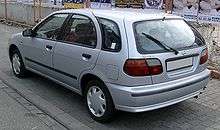
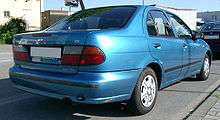
.jpg)
The first Nissan Almera rolled off the production line in late 1995, as a replacement for the Nissan Sunny (N14), a nameplate which had been in use for nearly 30 years. The Almera was almost identical to the Nissan Pulsar (N15) sold in Japan, except with different trim options and petrol engine range.
Power came from 1.4 GA14DE and 1.6 GA16DE petrol and 2.0 CD20 diesel engines initially in 1995, but a year into production a 2.0 SR20DE-engined GTi was added to the range. The 1.4, 1.6 and 2.0D engines were available in a three- and five-door hatchbacks that were badge engineered versions of the Japanese market Nissan Pulsar Serie or a four-door saloon, whereas the GTi was only available in three-door hatch.
In the UK, the Almera was originally marketed by Nissan as "the car they don't want you to drive".[1] Almost all Almeras sold in the United Kingdom were hatchbacks with three or five doors in contrast to regions such as Ireland, where the saloon version is substantially more commonplace. The level of specification was good, with all models getting power steering, driver airbag, electric mirrors and stereo as standard. Throughout the life of the Almera, many 'special editions' models were available but most of them didn't feature anything above other models.
Pre-facelift
Flagship models for each engine capacity are as follows:
- 1.4 Si GA14DE
- 1.6 SRi GA16DE
- 2.0 GTi SR20DE 140ps/131 Lbf (GA engine1996 onwards, sold in bodykit and non-bodykit form)
The above all included 'high-spec' bumpers with foglights (Optional on the Si model), alloy wheels from 1996 onwards (Different size and design between Si/SRi 14" and GTi 15"), and rear roof lip spoilers (GTi models sported an integrated brake light, also spoilers were optional on the Si).
The 2.0-litre GTi had an optional 'aggressive-looking' factory bodykit, with BMW M3-style side skirts, and front/rear splitters. Non-bodykit models came with a simpler plastic front splitter. The GTi featured uprated suspension, front and rear strut braces and a quicker steering rack,
Facelift
Almera received a facelift for 1998 model year. For the phase 2, the front bumpers were re-designed, front splitters were added on the Si/SRi, and the GTi had all-round bodykit as standard (Although it was optional to not have the bodykit), and now all of the lip spoilers had integrated brake lights. The original telescopic radio aerial was moved from the drivers A-pillar to the rear of the roof and was changed to a "bee-sting" type. On the GTi, the phase 2 headlights and front indicators featured a black surround.
The bodykit itself was changed to a more subtle, straight design on the GTi, with the addition of vents on the rear splitter. Due to the high 'casualty rate' of Phase 1 splitters, due to the thin and brittle plastic used, Phase 2 bodykits were much sturdier. As such, it is not uncommon to find Phase 1 GTi's with Phase 2 bumpers or no splitter at all.
Towards the end of production around the start of 1999, the GTi models came with all optional extras as standard from the factory such as ABS, A/C, updated interior trim, front seat pockets and so forth.
Second generation (N16; 2000)
| Second generation (N16) | |
|---|---|
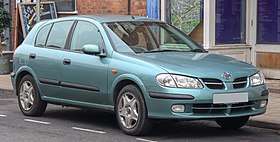 | |
| Overview | |
| Also called | Nissan Bluebird Sylphy Nissan Pulsar |
| Production | 2000–2006 (UK/ZA) 2001–present (Latin America) |
| Assembly |
|
| Designer | Yusuke Kojima (1997) |
| Body and chassis | |
| Body style | 3-door hatchback 4-door sedan 5-door hatchback |
| Platform | Nissan MS platform |
| Powertrain | |
| Engine | 1.5 L QG15DE I4 (petrol) 1.5 L K9K I4 (diesel) 1.8 L QG18DE I4 (petrol) 2.2 L YD22DDTi I4 (diesel) |
| Dimensions | |
| Wheelbase | 2,535 mm (99.8 in) |
| Length | 4,184 mm (164.7 in) |
| Width | 1,706 mm (67.2 in) |
| Height | 1,448 mm (57.0 in) |
| Curb weight | 1,285 kg (2,833 lb) |
| Chronology | |
| Successor | Nissan Tiida (C11) |

Launched in January 2000, the second-generation Nissan Almera differed from its predecessor with smooth, curved lines. Some still thought it bland in comparison with its rivals although the Almera was selling strongly worldwide.
For Europe, this generation of Almera was produced at the Sunderland factory, which had opened in 1986 and produced the Micra, Primera and originally the Bluebird.
The N16 Almera was based on Nissan's global MS-Platform, which was Nissan's first new platform to be developed after the partnership with Renault. The MS Platform was also the base for the new Primera and Almera Tino.
The second-generation Almera was available in three different body styles, a three- or five-door hatch and a four-door saloon with 1.5 and 1.8 Nissan QG engine series petrol engines as well as a 2.2 direct injection turbodiesel (110 bhp) (YD22DDT) or common-rail turbodiesel (136 bhp) (YD22DDTi). Almeras can be also equipped with 1.5 common-rail turbodiesel (dCi) from the Renault Megane II – Nissan had recently ventured with Renault and the Almera's diesel engine was one of the first instances of Nissan and Renaults sharing mechanicals. Early versions of the 1.5-litre engine were fitted with a mechanical throttle, which was later replaced by a drive-by-wire electronic throttle.
The Almera five-door hatchback was exported from the UK to Australia and New Zealand and sold as part of the Nissan Pulsar (N16) lineup in these countries. The Almera sedan is based on the Bluebird Sylphy, but has a different front end.
The N16 Almera offered great improvements over the previous generation Almera in terms of handling, tyre grip and drive dynamics. The N16 Almera felt much more sure-footed on the road and was exceptionally nimble for a plain family car.
While the previous generation Almera was considered spacious for its class, the N16 Almera was lacking in rear passenger legroom due to a slightly shorter than category average 2.53 metres (99.6 in) wheelbase although the Almera can still can be considered quite spacious and has the advantage of a bigger boot over the previous Almera.
Facelift


In 2003, the Almera was facelifted with updated styling, retuned suspension, new engines and an updated interior.
First, the Almera's MacPherson strut front suspension and multi-link rear suspension (Nissan's name for its double lateral link twist beam suspension) had been retuned. This resulted in a quieter ride and a reduction in the amount of rear bump-through experienced when heavily laden, improving high-speed stability, driving dynamics and making the car more controllable after an emergency manoeuver. The new suspension tuning also proved to produce almost no body roll on tight turns. Overall, Nissan said, the Almera had slightly firmer damper settings and marginally stiffer spring ratings; though there had been no loss of ride comfort or increase in noise levels in normal motoring. The suspension revisions had been executed in such a way as to only come into play at the upper edge of the dynamic envelope.
The facelift also included new chrome, projector-style headlights that were set in a titanium-coloured surround with separate lights for main and low beams set behind an enlarged translucent cover. The front bumper now had an integrated engine air intake that ran almost the full width of the car while a honeycomb mesh grille added visual benefits to the frontal image. Some models also got small circular fog lights.
The interior of the facelifted Almera had also been redesigned with better quality materials and a large colour or monochrome centre screen which controlled all of the car's functions (climate control, CD player and trip computer) was fitted to most models apart from S and Pulse. Higher trim levels also included Nissan's Bird-eye GPS system. ESP (Electronic Stability Program) was fitted to SE, SVE and the range topping SXE (which also got a switch to turn the ESP on or off).
Additionally there was a change to the diesel model lineup. Nissan introduced new version of Common Rail 2.2 Diesel with 6-speed gearbox.
Production
The facelifted Almera was built in Sunderland, Tyne and Wear, UK, and exported to parts of the Asia-Pacific where it was sold as the Nissan Pulsar. In 2006 the second-generation Almera reached its sixth year of production but was still selling strongly worldwide. It was also sold in Mexico in three versions: a five-door manual five-speed, a five-door automatic three-speed "Comfort" model and a three-door "Sport" version equipped with side curtain air bags, fog lamps and a five-speed manual transmission.
The Almera finished production on 29 November 2006, but it was not instantly replaced. The Tiida was introduced in several countries as a replacement model throughout 2007 and 2008; although it has yet to be officially imported to the United Kingdom (where the Qashqai crossover is the only successor model on offer), it has been available there through the Arnold Clark dealership network since March 2009 with models sourced from the Republic of Ireland.[4]
B10 (2006–2010)
In 2002, Renault Samsung Motors in South Korea started manufacturing the Renault Samsung SM3, a car based on the Nissan Bluebird Sylphy N16, equally as the second generation of the Nissan Almera. It was facelifted in 2005, and from April 2006, it started selling as the Almera Classic in Ukraine and Russia, as the Almera B10 in Central America, Venezuela and Ecuador, and as the Sunny B10 in the Middle East. In Colombia, Mexico, Libya and Egypt, the car has been sold as the Renault Scala and in Chile as the Samsung SM3.
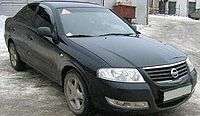 Nissan Almera (B10, 2006–2010)
Nissan Almera (B10, 2006–2010)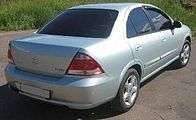 Nissan Almera (B10, 2006–2010)
Nissan Almera (B10, 2006–2010)
Third generation (N17; 2011)
| Third generation (N17) | |
|---|---|
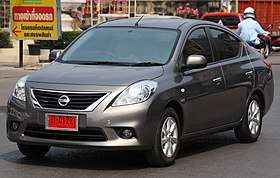 | |
| Overview | |
| Also called | Nissan Latio (Japan) Nissan Versa (Americas) Nissan Sunny Renault Scala (India) Nissan V-Drive (Mexico, since 2020) |
| Production | 2011–present |
| Assembly | Brazil: Resende China: Guangzhou Egypt: 6 October[5] India: Chennai Malaysia: Serendah (TCMA) Mexico: Aguascalientes[6] Philippines: Santa Rosa, Laguna[7] Thailand: Samut Prakan (Nissan Motor (Thailand) Co.,Ltd) Vietnam: Da Nang (TCIEV) |
| Body and chassis | |
| Body style | 4-door sedan 5-door hatchback |
| Platform | Nissan V platform |
| Related | Nissan Micra/March (K13) Nissan Note (E12) |
| Powertrain | |
| Engine | |
| Transmission | 4-speed RE4F03C automatic 5-speed RS5F91R manual RE0F11A Xtronic CVT |
| Dimensions | |
| Wheelbase | 2,600 mm (102.4 in) |
| Length | 4,425 mm (174.2 in) |
| Width | 1,695 mm (66.7 in) |
| Height | 1,500 mm (59.1 in) |
| Curb weight | 1,020 kg (2,249 lb) |
| Chronology | |
| Predecessor | Nissan Tiida (C11) |
_in_Cyberjaya%2C_Malaysia_(02).jpg)
In October 2011, Nissan launched a new model as the economical saloon car for the Eco-Car project in Thailand, which was named Nissan Almera. The car is a rebadged version of the Nissan Latio (N17), which is based on the company's global V platform. It is equipped with the same 1.2-litre petrol engine (HR12DE) as the Nissan March and has either a five-speed manual or a CVT transmission. The name is also used for the car in Malaysia, Australia, Indonesia, Singapore, Mauritius and Nigeria.
In 2013, Nissan launched the Latio as the Almera in the Philippines[7] and Malaysia.[8]
The third generation Nissan Almera is currently produced in some African and Asian markets like Ghana, Kenya, Mauritius, Nigeria, South Africa in Africa and Malaysia, Philippines, Thailand in Asia and other Asian countries. It is available with a 5-speed manual or a 4-speed automatic transmission.
In Mexico, the previous-generation Versa was renamed to V-Drive, to avoid confusion with the new-generation Versa launched in October, and drops the Sense and Advance trim lines.
Fourth generation (N18; 2019)
| Fourth generation (N18) | |
|---|---|
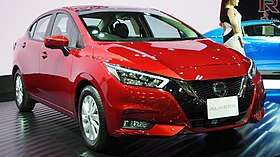 Nissan Almera 1.0 Turbo VL (N18, Thailand) | |
| Overview | |
| Also called | Nissan Versa (Americas) Nissan Sunny[9] |
| Production | 2019–present |
| Assembly | Brazil: Resende Malaysia: Serendah (TCMA) Mexico: Aguascalientes Philippines: Santa Rosa, Laguna Thailand: Samut Prakan (Nissan Motor (Thailand) Co.,Ltd) Vietnam: Da Nang (TCIEV) |
| Body and chassis | |
| Body style | 4-door sedan |
| Platform | Nissan V platform |
| Related | Nissan Micra (K14) Nissan Kicks (P15) |
| Powertrain | |
| Engine | 1.0 L (HR10DET/HRA0) IG-TURBO I3 1.5 L (HR15DE) I4 1.6 L (HR16DE) I4 |
| Transmission | 5-speed Nissan FS5W71 manual Jatco CVT7 JF015E (RE0F11B) Xtronic CVT |
| Dimensions | |
| Wheelbase | 2,620 mm (103.1 in) |
| Length | 4,495 mm (177.0 in) |
| Width | 1,740 mm (68.5 in) |
| Height | 1,460 mm (57.5 in) |
| Curb weight | 1,070–1,180 kg (2,358.9–2,601.5 lb) |
The fourth generation Almera was unveiled on 12 April 2019 at the Rock the Ocean's Tortuga Music Festival in Fort Lauderdale, Florida, United States, as the third generation Versa sedan, one week before its public debut at the 2019 New York International Auto Show.[10] Sales began in August 2019, for the 2020 model year. It is still based on the Nissan V platform, which is shared with the fifth generation Micra. In the United States, the third generation Versa is available in three trim levels: S, SV and SR. The new Versa will include the Nissan Safety Shield of driver assistance technologies as standard equipment, as well as a push-button ignition, a seven-inch, touchscreen audio system, a cruise control, and power windows and door locks. Up-level Versa trims offer features such as aluminum-alloy wheels, Apple CarPlay and Android Auto smartphone integration, SiriusXM Satellite Radio, a TFT LCD instrument cluster display screen, LED daytime running accent lamps (DRL's), the Nissan Intelligent Key system, and combination Primatex (leatherette) and cloth seating surfaces.
The third generation Versa sedan came to the Mexican market on 1 October 2019 with prices coming between MXN$239,900 and MXN$322,500. It comes in four trim lines: Sense, Advance, Exclusive, and Platinum.[11] The previous-generation Versa will still be on sale in Mexico, although with less trim lines than its new generation, and will be named V-Drive.[12]
The fourth generation Almera was launched in Thailand on 14 November 2019[13] and has also been set for introduction in Malaysia as well.[14] In Thailand, the Almera is offered in 5 trims: S, E, EL, V and VL. All trims are powered by the HRA0 turbocharged 1.0 L engine. The Sunny was also launched in the United Arab Emirates at the Dubai International Motor Show in November 2019.[9]
In Brunei, the Almera was officially launched on 27 February 2020. The car is only available with the 1.0-litre turbocharger engine and Xtronic CVT in this market, in two different trims: Turbo (base) and the better equipped Turbo S.[15]
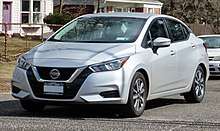 2020 Nissan Versa SV (North America)
2020 Nissan Versa SV (North America)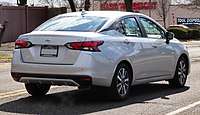 Rear view
Rear view
Other versions
G11 (2012–2018)
In Russia, the new Nissan Almera was based on the Nissan Bluebird Sylphy G11 presented in 2005. It received its world premiere at the 2012 Moscow International Automobile Salon on 29 August 2012, and uses the same design as the Bluebird Sylphy but a redesigned dashboard interior, adapted from the first generation Dacia Logan. It has a 1.6-litre petrol engine (75 kW), with a five-speed manual or a four-speed automatic transmission, and is manufactured locally at the AvtoVAZ plant since December 2012. Sales began in April 2013 and stopped in October 2018.[16]
See also
- Nissan Pulsar, the original car upon which the Almera was based
- Nissan Bluebird Sylphy (G10), the car upon which the second generation were based on.
- Nissan Bluebird Sylphy (G11), the car upon which the Russian models is based on.
- Nissan Sunny, another compact car built on the same platform. From 2012, the Almera N17 has been sold as the Sunny in some markets.
- Nissan Sentra, another contemporary compact car of the manufacturer. From 1995 to 1999, the first generation Almera was sold as the Nissan Sentra in New Zealand.
- Nissan Almera Tino, a related compact MPV developed on the same platform
- Nissan Motor Manufacturing UK, the manufacturing facility for the second generation
References
- Marshall, Caroline "BACKBITE", BrandRepublic, 27 June 1997. Retrieved on 7 July 2015.
- "Nissan. Nissan in South Africa". Car-cat.com. Archived from the original on 10 May 2012. Retrieved 16 July 2010.
- "Nissan. Nissan in Great Britain". Car-cat.com. Archived from the original on 16 May 2013. Retrieved 25 July 2010.
- "Unusual visitor's a Tiida little number". The Daily Record. 3 April 2009. Retrieved 16 July 2010.
- "Nissan Egypt maintains full production despite currency crisis". 21 March 2016. Retrieved 16 September 2018.
- "Aguascalientes fabricará el nuevo Nissan". cnnexpansion.com. 24 June 2011.
- Ang, Jason K. (28 May 2013). "Little Cars That Are Big Inside". Philippine Daily Inquirer. Retrieved 9 June 2013.
- "In Malaysia, Nissan Almera Gets Nismo Performance Package". Top Gear Philippines. 19 June 2013. Retrieved 19 June 2013.
- https://www.drivearabia.com/news/2019/11/14/nissan-sunny-2020-middle-east-debut-at-dubai-motor-show/
- https://www.motor1.com/news/344275/2020-nissan-versa-debut/
- https://www.motorpasion.com.mx/industria/nissan-versa-2020-precios-versiones-equipamiento-mexico
- https://www.motorpasion.com.mx/industria/nissan-versa-anterior-se-mantendra-mexico-asi-se-llamara-ahora
- https://www.autoindustriya.com/auto-industry-news/turbocharged-2020-nissan-almera-arrives-in-thailand-is-ph-next.html
- https://paultan.org/2019/04/30/new-n18-nissan-almera-and-kicks-crossover-coming-to-malaysia-in-2020-new-sylphy-also-on-the-cards/
- Roslan, Wani (27 February 2020). "All-new Nissan Almera unveiled". Borneo Bulletin. Borneo Bulletin Online.
- "Nissan Almera Sedans Go on Sale". Wroom.ru. 15 April 2013. Archived from the original on 1 May 2013. Retrieved 1 December 2013.